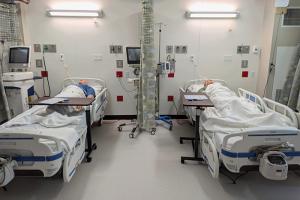Take action, make progress

Image from Getty Images
The more action you take, the more progress you make. While this well-worn phrase may seem like something one would find on a motivational poster, there is truth within its message — and it’s singularly accurate in describing what motivates advocacy efforts in the health care facilities field.
If facilities professionals don’t take action, the codes, standards, guidelines and regulations that rule health care facilities won’t change — at least for the better, says Chad Beebe, AIA, CHFM, CFPS, CBO, FASHE, deputy executive director of the American Society for Health Care Engineering (ASHE) and head of its Regulatory Affairs Team.
“Get involved at the local, state and national level because it supports the reason many of us get into health care facilities management — to positively impact patients through our work behind the scenes,” Beebe says. “Help eliminate unnecessary regulatory burdens that drain time and resources from patient care, whether by restricting efficient services or driving up operational costs.”
Input from the health care facilities field is crucial for informing regulatory groups about what’s working, what’s not and what’s missing in codes, guidelines and standards. In this article, ASHE’s Regulatory Affairs Team discusses the most important health care facilities management advocacy, regulatory and compliance issues impacting the field in 2025 and shares how facilities professionals can get involved.
Convincing CMS to update its CoP editions
The issue: To get paid by health care’s largest payer — the Centers for Medicare & Medicaid Services (CMS) — hospitals need to meet CMS’s Conditions of Participation (CoP), which include following the National Fire Protection Association’s NFPA 99, Health Care Facilities Code, and NFPA 101®, Life Safety Code®. CMS continues to require health care facilities to follow the 2012 version of these two code sets, even though NFPA has updated NFPA 99 and NFPA 101 several times in the last 13 years.
Why it’s a problem: In 2012, singer Taylor Swift was still a country artist, and Barack Obama was in his first presidential term. The point: a lot has changed in the world since 2012, including health care. The 2012 versions of NFPA 99 and NFPA 101 are now outdated, Beebe says, and they don’t include important updates made to the codes that address changes in technology and care standards over the past 13 years.
For example, use of electrical system microgrids has risen in popularity with health care facilities in recent years to save on energy costs. While new microgrid technology has made this an attractive option for hospitals, the 2012 edition of NFPA adopted by CMS does not allow their use. Instead, CMS has issued a categorical waiver, but facilities must still notify surveyors during each survey if they are utilizing the waiver to prevent citations. Additionally, some states that adopted the 2012 NFPA standards to align with CMS do not have a mechanism in place to recognize conditional waivers.
Other regulatory bodies also refer to NFPA 99 and NFPA 101 in their guidelines, codes and standards, including at the local and state level. But these regulators have adopted newer versions of the code sets, for example, in local building codes, which then requires health care facilities to make sure they meet the 2012 versions for CMS and more recent versions for other authorities having jurisdiction (AHJs). This creates code conflicts, duplicative standards and unnecessary burdens on hospitals, Beebe says.
“With each year, we are getting further away from code coordination, which is creating more and more conflicts. The rest of the world has moved on with newer technologies and better standards that provide better care,” Beebe says.
How to take action: While momentum seemed to be building last year toward CMS updating to the 2024 NFPA editions, the recent administration change in the federal government and the reorganization/restaffing of CMS that followed have reset the effort. ASHE and the field need to communicate to the new administration why using the 2012 editions presents a regulatory burden on health care facilities and how moving to the 2024 editions would reduce that burden and improve efficiency and care, Beebe says. In short, be vocal by sending letters to CMS asking for these code updates. “We are pushing for CMS to adopt the 2024 version, but really any other edition more recent than the 2012 edition — it’d be nice to get our regulations into this decade,” Beebe says. “It is important that hospitals are given the options to use technology that is on the market today and not be held back by old rules.”
The Joint Commission’s consolidated standards
The issue: In July, the accreditation organization The Joint Commission announced that it has reorganized and rewritten the standards it uses for surveying health care facilities.
Why it’s a problem: There are pros and cons to this change, says Leah Hummel, AIA, CHFM, CHC, CHOP, SASHE, senior associate director for ASHE Regulatory Affairs. The Joint Commission previously spelled out details of its requirements but sometimes in ways that conflicted with the exact language of the code the requirement was referencing. The consolidation of The Joint Commission standards removed some of that detail and now points people directly to the referred codes and standards for specifics, which will better align the standards with the CMS CoP and other codes/standards, reducing conflicts — especially when edition updates are made.
But like any change, it will require health care facilities managers to take a detailed look at the referenced codes and standards if their organization seeks The Joint Commission accreditation, which is voluntary. “What is changing is the standards are going to simply reference the [external] codes and standards versus trying to repeat what they say using different terminology,” Hummel says. “Wording matters in these codes. To understand what you must do to be compliant with The Joint Commission, you’ll have to become more knowledgeable about the field’s codes, for example, the details of NFPA 101 or NFPA 99, and other related codes deeper down in NFPA that 101 and 99 point to.”
How to take action: Facilities managers whose organizations seek The Joint Commission accreditation will need to become savvier about what is in the actual codes instead of relying on The Joint Commission guidance. “This could open the door for more things to be cited during surveys,” Hummel warns. “There is just so much to learn.” ASHE is updating its education offerings, including the Physical Environment Survey Readiness Program and code crosswalks, to help guide facilities managers through the changes. Reviewing The Joint Commission’s Survey Activity Guide and Comprehensive Accreditation Manual also is recommended.
ASHRAE/ASHE Guideline 43 now available
The issue: For years, the health care facilities field has followed American National Standards Institute/ASHRAE/ASHE Standard 170, Ventilation of Health Care Facilities, for the operation of their heating, ventilating and air-conditioning (HVAC) systems. This included keeping the temperature in patient rooms within a standard range of 70 F to 75 F, even if patient care or comfort called for adjusting the temperature outside of that range. The new ASHRAE/ASHE Guideline 43, Operations Guideline for Ventilation of Health Care Facilities, released in June, takes a detailed look at best practices for the operation of HVAC systems and offers guidance for using an HVAC system to optimize care and comfort.
Why it’s needed: Before the development of Guideline 43, the field was spending a lot of resources complying with Standard 170, which as a design standard is not optimized for operation. “With older patients or patients who are sick and having trouble maintaining body temperature, 72 F isn’t warm enough,” says Jonathan Flannery, MHSA, CHFM, FASHE, FACHE, senior associate director, ASHE Regulatory Affairs, who has worked on the committee writing and publicly vetting Guideline 43 for the last five years. “Many times I’ve walked through a hospital and seen patients with five blankets on them just to sleep comfortably, and we know that impacts the healing process.”
Guideline 43 provides greater flexibility for those requirements and allows for the customization of HVAC system operation. For example, the new guideline allows a multidisciplinary team to look at the role temperature plays in risk of surgical site infections and adjust the system appropriately to reduce that risk.
How to take action: Use the guideline in the development of a ventilation management program for the operation of HVAC systems. The guideline even offers an appendix listing nine steps for implementing a ventilation management program. Guideline 43 is now available online.
FGI Guidelines scope expansion
The issue: The Facility Guidelines Institute’s (FGI’s) Guidelines are used by many AHJs as standards governing the planning, design and construction (PDC) of hospitals and other health care facilities. While the Guidelines overall provide needed guardrails for the field to ensure the creation of efficient and comfortable health care facilities, some areas of the Guidelines have begun to expand their scope, entering the territory of other codes and standards requirements and even conflicting with those rules, ASHE officials say.
Why it’s a problem: FGI issuing guidance on areas of health care PDC already covered by other codes and standards entities creates conflicts for health care facilities professionals who then need to follow multiple, sometimes conflicting, rules, Beebe says. Even worse, a health care organization could build a facility following FGI guidance only to be cited for that design by local building inspections post-construction due to code conflicts, followed by citations from CMS AHJs during operation, causing additional costs and delays in providing care to fix new construction, Hummel says. Another issue: state AHJs often adopt FGI Guidelines as their design requirements but do not all use the same edition. This makes complying with the Guidelines especially difficult for health care systems operating in multiple states.
“It is problematic if FGI is repeating but tweaking what is said in other regulations,” Beebe says. “We want all the guidelines and standards to stay in their lanes.” New changes by FGI will hopefully help address the issue. With its 2026 edition, FGI is overhauling the guidelines and splitting them into two series of documents: the FGI Facility Code, which will be used in AHJ enforcement, and a handbook that will be more descriptive and supplemental of the code, which is not enforceable by AHJs.
How to take action: Facilities professionals should monitor for scope creep during FGI public comment periods related to its 2030 edition, and if they see a current FGI guideline that conflicts with other codes and standards, they should submit a proposal to correct that conflict. While the intent of this scope creep is well-meaning — FGI committees, made up of representatives from across the health care field, are trying to ensure their guidelines are “a one stop shop that takes you through different layers of design,” Hummel says — the result can lead to overly detailed guidance that conflicts with other regulations. ASHE representatives also will be monitoring this through their
work on the FGI Health Care Guidelines Revision Committee.
Groups pushing for overly “qualified” damper inspections
The issue: NFPA 80, Standard for Fire Doors and Other Opening Protectives, states that individuals conducting inspection and testing of fire and smoke dampers must be “qualified.” This means the inspector must possess a recognized degree, certificate, professional standard or relevant skills and have demonstrated the ability to manage performing the task through knowledge, training and experience. Properly trained in-house engineering staff can perform these inspections per the code. But recently, several jurisdictions — including Washington state, Nevada, Illinois, St. Louis and Pittsburgh — have received petitions from special interest groups advocating that regulations be developed that allow damper inspections to be conducted only by people with specialized certifications and union affiliation.
Why it’s a problem: ASHE recognizes the vital importance of these inspections for fire and life safety but has concerns about limiting them to only personnel certified to this standard — which favors union contractors, Hummel says. There are many cash-strapped hospitals — including critical access hospitals — that must rely on in-house staff to conduct these inspections. “It’s disheartening as these groups are not being transparent with legislators when discussing this issue,” Hummel says. “They say, ‘Fire dampers can fail and need to be inspected,’ and legislators of course say, ‘Oh wow, yes they do,’ but they already have to be inspected … the actual change they are seeking is for the inspection to be made only by members of their union. This doesn’t increase the safety of dampers in any way.”
Inspecting and testing a damper requires a fundamental understanding of its mechanics — knowledge that can largely be acquired through training and manuals. However, working within patient care spaces demands a far greater level of expertise. It requires a deep familiarity with health care environments, infection control protocols and the intricate facility-specific systems that must be carefully navigated to avoid unintended disruptions.
“Each hospital or medical facility has unique shutdown procedures, patient safety considerations and operational complexities that must be managed with precision,” Beebe says. “Entrusting damper inspections to someone with only textbook knowledge risks dangerous oversights — potentially jeopardizing patient health. The real priority must be ensuring that those conducting even the most basic inspections possess the experience to anticipate risks, make informed decisions and uphold the stringent safeguards necessary in health care settings.”
If such inspections can be safely and expertly completed without specific qualifications, Beebe asks, why institute legislation that requires only contractors complete the task? “We have to be advocating for the ability to inspect and test our own equipment,” Beebe says. “For one, no one knows it better than we do. But also, if we allow consultants to dictate where their services are required through legislation, it unnecessarily drives up costs.”
How to take action: Get involved with a state ASHE Chapter’s advocacy team and speak out against legislation requiring special certifications, unions or consultants to inspect dampers or other health care facilities equipment. Do not accept individuals who only hold a generic International Organization for Standardization/International Electrotechnical Commission 17024 certification. Instead, ensure that they hold ASHE’s Health Care Physical Environment Worker credential and are a Certified Health Care Constructor before allowing them into a facility. These qualifications are essential for maintaining the highest standards of safety and expertise in health care environments.
Advocating for change
There are many reasons to get involved with advocacy, the most direct being to help determine the rules health care facilities will operate under. But there also is an obligation for a health care organization to increase efficiency and save time and resources, Beebe says.
How can facilities professionals get involved? Keep an eye out for ASHE’s Advocacy Alerts, which notify the field via email of issues and calls to action that will impact codes, standards and regulations. Watch for public comment periods to open on codes and standards to offer adjustments and recommendations, says Austin Wallace, MA, sustainability senior specialist at ASHE.
ASHE members can visit MyASHE online and share their experiences of regulations gone wrong. ASHE often mines the platform when looking for examples to back up calls to change regulations. If the issue is sensitive, Beebe says to email him directly (cbeebe@aha.org) or a local ASHE Chapter and raise the concern. “The ASHE Regulatory Team can’t do our job without your first-hand experience,” he says.
If facilities professionals are not engaged in the development of regulations, it gives others “the opportunity to force you to do something that just isn’t needed,” Flannery says. “Your time is extremely limited, but if everyone puts forth a little effort, together we can ensure our field’s voice is heard and reflected.”
Facilities professionals also should monitor state legislation and talk to state legislators about the issues impacting them. When it comes to codes, standards and regulations, it is “a food web, not a food chain,” in terms of who has jurisdiction, Wallace says. “Getting involved at the state level is important because they are incredible allies when it comes to monitoring local policy that comes out.”
“People often say, ‘They are making me do this, but it is a waste of money, it isn’t doing anything,’” Beebe says. “That is when you need to speak out about it. Unless you are advocating for change with someone outside your organization, you are not really doing anything.”
In other words, if you’re not helping to make it right, then you can’t complain about it being wrong, Hummel says.
Related article // Additional changes for health care facilities to monitor
Advocacy work is like plugging leaks in a submarine, says Austin Wallace, MA, sustainability senior specialist at the American Society for Health Care Engineering (ASHE). “You plug one and another one pops up, and you must work to maintain the correct depth,” he says. “The work is never done, and you need to stay alert.” A quick survey of other issues important to facilities professionals includes:
- New American National Standards Institute/ASHRAE/ASHE Standard 170, Ventilation of Health Care Facilities, edition almost final. The 2025 edition of the heating, ventilating and air-conditioning design standard, which is enforced by several authorities having jurisdiction, is expected to be released this year. This updates the standard from the 2021 edition.
- National Fire Protection Association’s NFPA 99, Health Care Facilities Code, committee reviewing ventilation systems chapter. With the release of ASHRAE/ASHE Guideline 43, Operations Guideline for Ventilation of Health Care Facilities, an NFPA task force is investigating whether NFPA 99’s Chapter 9, which centers on ventilation systems, should require health care systems to implement a ventilation management program. Guideline 43 wouldn’t be the required program, says Jonathan Flannery, MHSA, CHFM, FASHE, FACHE, senior associate director, ASHE Regulatory Affairs, but would be included as an informative guidance document. ASHE has submitted comments to NFPA supporting this change. If the full NFPA 99 committee approves the program requirement, it would be added to the code’s 2027 edition.
- New ANSI/ASHRAE/ASHE Guideline 189.3, Design, Construction and Operation of Sustainable High Performance Health Care Facilities, edition expected this year. ASHE representatives are serving on the committee updating Guideline 189.3. The new energy-efficiency guideline offers best practices on areas including site water use, irrigation and laboratory facility operation.
Related article // Monitoring ever-evolving energy-efficiency standards
Agrowing number of local and state jurisdictions have begun to implement energy-efficiency building performance standards, American Society for Health Care Engineering (ASHE) officials say, which govern hospitals and other health care facilities.
The move to conserve resources and save costs is an important one for sustainability advocates, says Austin Wallace, MA, sustainability senior specialist at ASHE. But some of the standards are being set for jurisdictions without considering the special circumstances of hospitals, which typically need more energy to operate compared to other building types. “The data jurisdictions [they] are using to set those target numbers are not quite as representative for hospitals, so the goals or rules that are being set are rather ambitious,” Wallace says. This presents an opportunity for advocacy at the local and state level through ASHE Chapters.
For instance, the city of Denver recently passed an energy use intensity (EUI) target for buildings that was shaped in part through advocacy by the Colorado Association of Healthcare Engineers & Directors (CAHED).
When Denver proposed an EUI target that would be challenging for hospitals to meet, CAHED representatives used aggregate ASHE Energy to Care® data presented in the Energy Benchmarking for U.S. Hospitals report. The report, which is comprised of hundreds of hospitals, helped make the case for adjusting to levels more achievable for health care facilities.
“What happened in Colorado is a great representation of the two-way street that needs to happen in advocacy,” Wallace says. “At the national level, we only have so many eyes and ears. We really depend on our chapters, sustainability and advocacy liaison members to be the boots on the ground. We have strength in numbers, so rallying allies around legislation to ensure it is fair and effective at conserving energy will be huge.”
Chris Dimick is content development and communications manager at the American Society for Health Care Engineering and production editor at Health Facilities Management magazine.




